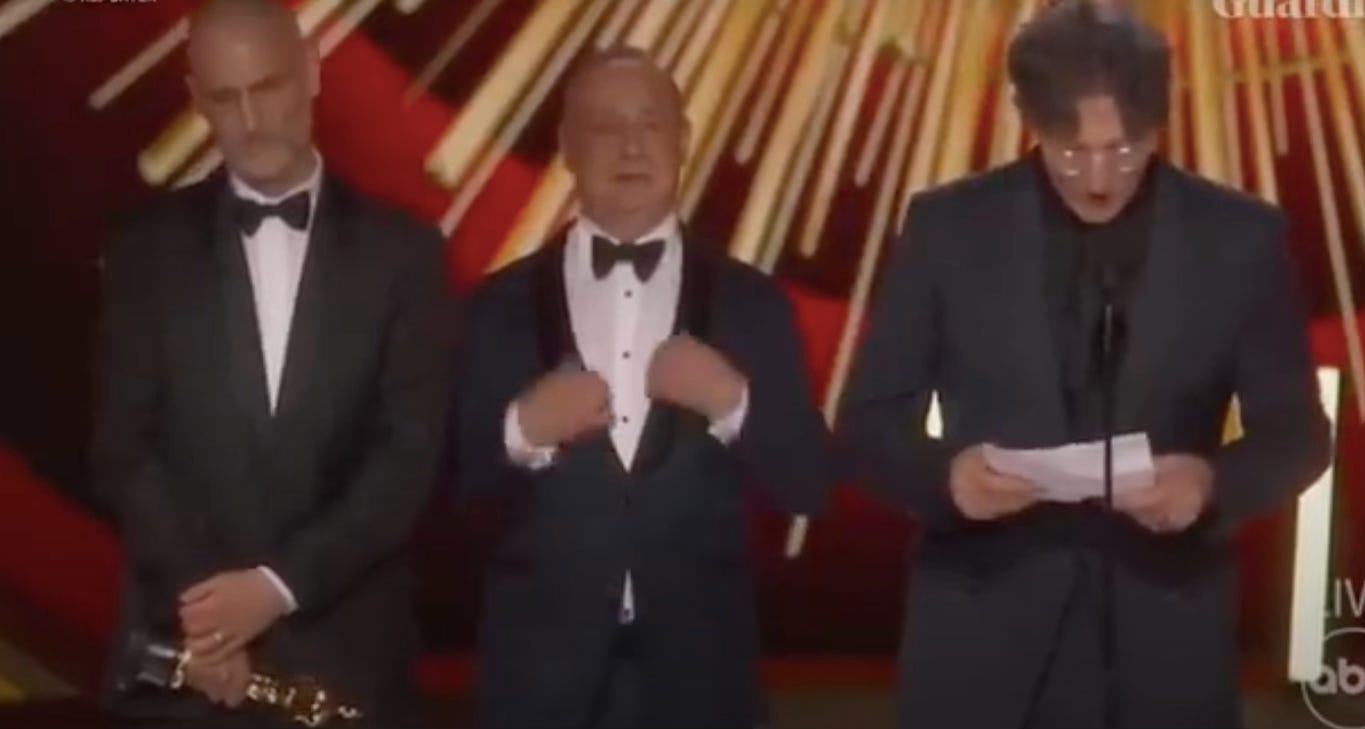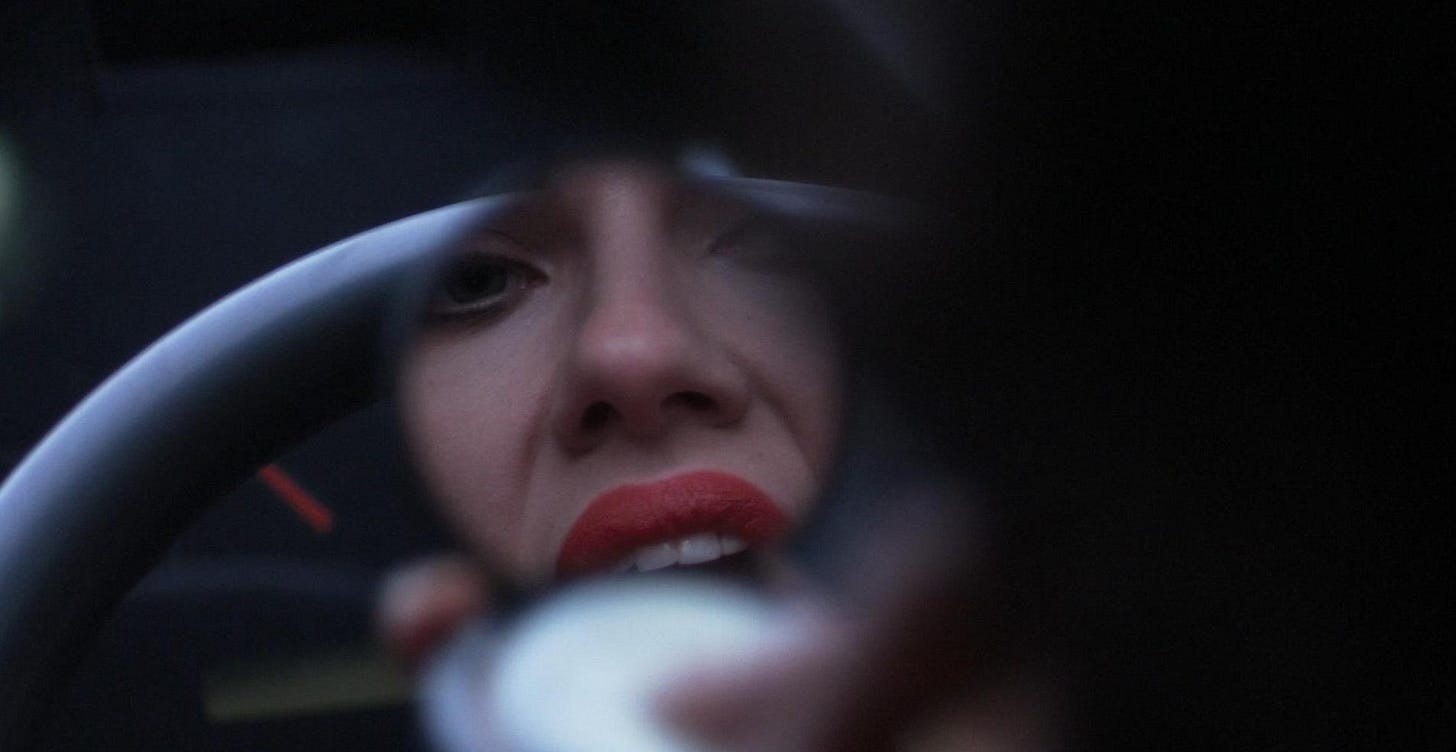Jonathan Glazer Gets Under The Skin
Another letter, favoring the Zone Of Interest director's Oscar speech, and a 2013 conversation about Under The Skin
“Right now we stand here as men who refute their Jewishness and the Holocaust being hijacked by an occupation, which has led to conflict for so many innocent people.”
Before the Oscars, I collected older, unpublished interviews I had with nominated filmmakers, including with Jonathan Glazer, from his previous movie, years ago, Under The Skin (2013). Since his acceptance speech—the film won for Best International Film and Best Sound for designer Johnnie Burn—”open letters” for and against his words have been promoted, particularly by Variety, which made much of a Google document that included obviously fictional names.
The latest letter (Variety article here) includes as many 500 signatories, including Lenny Abrahamson, Mark Asch, Yuval Avraham, Annie Baker, Amy Berg, Kate Berlant, Gregg Bordowitz, Serge Bozon, Charles Bramesco, Janicza Bravo, Margaret Brown, Dan Bucatinsky, Larry Charles, Michelle Citron, David Cross, Jeff Deutchman, Sandi DuBowski, David Ehrlich, Deborah Eisenberg, Nicole Eisenman, Frances Fisher, Naomi Foner, Esther Freud, Bella, Nan Goldin, Josh Gondelman, Elliott Gould, Michael Greif, Arthur Harari, Mark Harris, Todd Haynes, Eliza Hittman, Anna Rose Holmer, Nicole Holofcener, Miranda July, Sara Kiener, Alison Klayman, Naomi Klein, Pamela Koffler, Jenni Konner, Nadav Lapid, Mike Leigh, Tia Lessin, Jonathan Lethem, Mica Levi. Avi Lewis, Jennie Livingston, Richard Lorber, Darius Marder, Miriam Margolyes, Alan Menken, Nina Menkes, Avi Mograbi, Oren Moverman, Laraine Newman, Sierra Pettengill, Charlie Phillips, Summer Phoenix, Joaquin Phoenix, Rain Phoenix, Jeff Preiss, Francine Prose, Mark Rappaport, Boots Riley, Howard A. Rodman, Mark Romanek, Jonathan Romney, Jay Rosenblatt, Gary Ross, Ira Sachs, James Schamus, Sarah Schulman, Wallace Shawn, Sarah Sherman, Nathan Silver, Shawn Slovo, Tom Stoppard, Elisabeth Subrin, Jeremy Thomas, Lynne Tillman, V (formerly Eve Ensler), Alicia Van Couvering, Nick Wechsler, David Wilson, Debra Winger, Alex Winter, Jeremiah Zagar, Kate Zambreno, Amy Ziering and Debra Zimmerman.
Glazer’s conversation about Under the Skin is striking in the context of The Zone of Interest and reaction to his Academy Award acceptance speech: “It looks very different to how you may have imagined it.” (I wrote about Zone of Interest here.)
Jonathan Glazer, 28 March 2014.
Glazer and I talked in Chicago about the process of making Under The Skin and influences, notably the late Rainer Werner Fassbinder.
It’s akin to the lore of Michelangelo looking at a piece of marble and saying, I only have to carve away the part that isn’t David.
“Yeah, it’s a big block of marble,” Glazer says, leaning forward, speaking quietly. “The example you have just given is very beautiful, actually. The film, the process of making this film, was quite sculptural. It was about starting with a feeling, an image… Well, not an image but a feeling, a very clear feeling, and then trying to reveal that. Trying to articulate that. And until you feel like you’ve articulated it, you keep going, you know? And then you walk away at the end, when you feel you have got some way to putting that feeling up on a screen. And it looks very different to how you may have imagined it. And the form is, you know, it has its own thing, and the feeling is what you set out to try and articulate.” And then? “And then you are finished.”
Glazer worked with several writers, and a 2008 draft of the script opens with pages of description, including the opening, “A vast black surface runs back in infinite blackness.” Glazer says that the way to accomplish the film didn’t come, however, until most of that draft was scrapped in favor of dropping Johansson in guerilla fashion, driving a van with multiple tiny cameras in the cab, and a crew in the back, around the gray northern city, approaching strangers in hope a connection would spark, and then the nonprofessionals could become part of the film.
But what drives a director to stay at that process for so long? There’s a world of crap screenplays out there, where screenwriters are told, if you take more than twelve weeks to write your first draft you are wasting your time. You need to move onto the next thing.
Those things, the twelve-week things, I mean, how can there be any truth to that? I mean, it might be true to the person that wrote it. But each of us are different, we have our own approach and have our own methods. Neither one is more correct than the other. It is the paring away, but it took a long time to articulate it, to become aware that the methodology and narrative are the same thing. We spent a long time writing it, and the script ended up being fifty-odd pages long and it was mostly description, like a short novel. That’s still writing. That’s writing. You are writing with images.
The ideal film, you’re getting to dream someone else’s dream. The visual and aural qualities combine into a plastic object that is also a transporting experience.
I like for a film to be quite transporting. I’ve always been drawn to or got the most from films that take me away from my reality. And I travel when I am watching a film that is told that way. And they also explore the medium. And it’s a remarkable medium. It’s often ignored, really, it’s often sort of filmed theater. I think the power of the medium is there to be investigated. That’s what keeps me hooked for such a long period of time, and the spark of the story was enough to go on that journey.
Mike Leigh shrugs when asked about process, he says, in what he concedes is a “crap koan,” “A piece of string is as long as a piece of string.”
Fair enough you’re right. You are not looking at what you are doing, you are just in it. It becomes your laboratory.
Cinema can be both banal and wondrous.
Sometimes the clearer something is, the more mysterious it is, actually. There are films I love that are made by filmmakers that made… Fassbinder made god knows how many? Fifty films, fifty-five films?
Forty, maybe?
Forty films. I’ve seen as many as I can manage to get my hands on, probably most of them. You watch them like pages of a diary, really. Those films were there because that is how he felt. He was on planet Earth, and this was his experience of being on planet Earth. I wish that’s the way I could just roll it out back-to-back like that. I don’t seem to be able to do that. People talk about a box set of ‘The Wire’ or ‘Breaking Bad,’ my box sets are Fassbinder, and I will watch them back-to-back. And the impact is absolutely extraordinary.
There is a major, startling, brilliant moment among brilliant moments in Under the Skin, a disconnect between appearance and reality, as the creature discovers an essential difference from the humans who desire this female form.
That was the driving interest, really, with this film, the paradox of body and soul accounting for existential unease. This idea of her, being a literal conduit for what it is to be human. It’s just a fascinating character to explore. It’s unending. I never run out of interest for it. We never stopped talking about it, or trying to turn over the ideas until they all felt balanced. It is important to me to pick something I know I will be interested in for ‘as long as it takes.’ You know making a film is quite a big undertaking. And if I am going to do it I have to feel that I am certain in how fertile it is. It will need to grip me as long as it takes.
She’s like the sea really. She’s just dispassionate. There is no empathy, no individuation, no nothing. That’s the thing she wears. What is that phrase? ‘The suit wears the man, or the man wears the suit’? In the end, she is the man that wears the suit rather then the other way around. It’s just a sense of what she sees in that mirror. And what she sees, she begins to believe is her own identity and is trying to take ownership.





